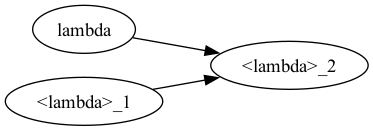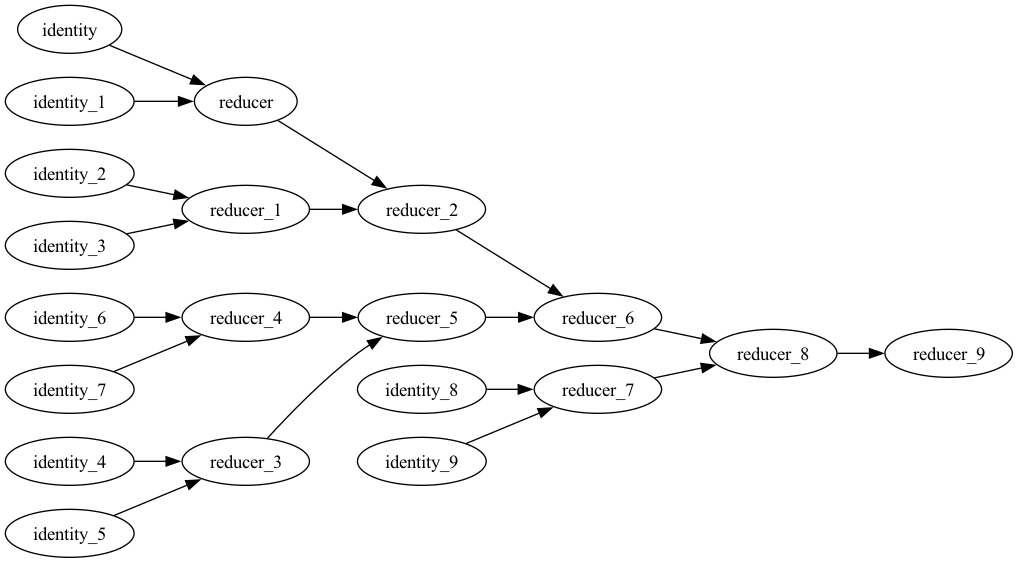This is a functional wrapper over ray framework using returns package. The returns package provides an idiomatic way of writing type classes such as Functor, Applicative, and Monad. The ray framework allows embedding a value as an ObjectRef and a function as a RemoteFunction. This package combines it together in a RayContext.
from rayfun.types import RayContext, RayNode
int_ref: RayContext[int] = RayContext.from_value(1)You can also wrap a function in the RayContext and call it remotely.
from rayfun.types import RayContext, RayNode
from typing import Callable
def add(a: int, b: int) -> int:
return a + b
add_ref: RayContext[Callable[[int, int], int]] = RayContext.from_value(add)The RayContext is defined as a Kind1["RayContext", _T] type. This allows us to support type classes provided by returns.
from rayfun.types import RayContext, RayNode
int_ref: RayContext[int] = RayContext.from_value(1)
int_ref.map(lambda x: x + 1) # RayNode[int] = RayContext.from_value(2)Internally, map uses Applicative to apply the function by first lifting it to RayContext by using RayContext.from_value. Thus ray_value.apply(RayContext.from_value(function)) and ray_value.map(function) are equivalent.
RayContext.from_value is equivalent to pure. It lift the value to the RayContext. It can lift values, functions (including functions with variable arguments). Note that the **kwargs is not supported and may not be supported in the future.
from rayfun.types import RayContext, RayNode
from typing import Callable
add = lambda x, y: x + y
int_ref: RayContext[int] = RayContext.from_value(1)
int_ref_1: RayContext[int] = RayContext.from_value(2)
add_ref: RayContext[Callable[[int, int], int]] = RayContext.from_value(add)
int_ref_1.apply(int_ref.apply(add_ref)) # RayNode[int] = RayContext.from_value(2)The above calculation first create two ray objects pointing to 1 and 2 respectively. And it then lifts the function add to a ray remote function. Finally, it is possible to apply the add function to its arguments in two steps as shown above. The apply method is equivalent to ap in Haskell. The above method provide a way to create a computation using ray as a context. Note that in both Mappable and Applicative cases, the computation is not immediately performed. The result of the application (or using apply) is a either a partially applied function or a FunctionNode that represents a DAG for the computation.
The DAG can be then executed using RayContext.run method. The run method reduces the DAG to a single value. You will be mostly interested in the reducing the value to an ObjectRef. You can further get the value from the ObjectRef using ray.get method. The following example showcases it. You can also plot the DAG by using RayContext.plot method. Note that you need to have pydot installed for this to work.
from rayfun.types import RayContext, RayNode
from typing import Callable
import ray
add = lambda x, y: x + y
int_ref: RayContext[int] = RayContext.from_value(1)
int_ref_1: RayContext[int] = RayContext.from_value(2)
add_ref: RayNode[Callable[[int, int], int]] = RayContext.from_value(add)
lazy_node = int_ref_1.apply(int_ref.apply(add_ref)) # ObjectRef[int] = ObjectRef(2)
node = lazy_node.run() # ObjectRef[int] = ObjectRef(2)
lazy_node.plot('dag.png')
ray.get(node.wrapped) # 3The DAG for the above computation looks like this.
which simply tells us that the computation running a function. Each node in the DAG represents a computation.
Using the above method, we can also run the computation in parallel. The following example shows how to do it.
from rayfun.types import RayContext, RayNode
from typing import Callable
import ray
add = lambda x, y: x + y
int_ref_1: RayContext[int] = RayContext.from_value(1)
int_ref_2: RayContext[int] = RayContext.from_value(2)
int_ref_3: RayContext[int] = RayContext.from_value(3)
int_ref_4: RayContext[int] = RayContext.from_value(4)
add_ref: RayContext[Callable[[int, int], int]] = RayContext.from_value(add)
intermediate_node_1 = int_ref_1.apply(int_ref_2.apply(add_ref))
intermediate_node_2 = int_ref_3.apply(int_ref_4.apply(add_ref))
result_node = intermediate_node_1.apply(intermediate_node_2.apply(add_ref))
result_node.plot('dag1.png')
result = result_node.run() # ObjectRef[int] = ObjectRef(10)
ray.get(result.wrapped) # 10The DAG for the above computation looks like this.
This clearly shows that the computation is now done in two stages. Note that these computations are distributed in the cluster and will run in parallel in the ray cluster.
The Bindable or Monad enforces an explicit sequencing of the computation. The RayContext provides a bind method to do this. The bind method is equivalent to >>= in Haskell. The following example shows how to use it.
from rayfun.types import RayContext, RayNode
from typing import Callable
import ray
square = lambda x: RayContext.from_value(x * x)
int_10 = RayContext.from_value(10)
int_10.bind(square) # RayNode[int] = RayContext.from_value(100)The above computation will not produce a graph with two computations. Instead, it will produce a graph with just one computation that involves squaring a value. It will fetch the value from int_10, feeds it to the square function and returns the result. It enforces that a computation must be completed before starting with another. This is useful when you want to run a computation in a sequence. In short, Applicative for a parallel computation, and Monad for a sequential computation.
This method allows using Applicative to create a reduction DAG. The following example shows how to do it.
from rayfun.types import RayContext, RayNode, from_iterable, parallel_reduce
from typing import Callable
import ray
inputs = range(10)
expected = sum(inputs)
def reducer(a, b):
return a + b
def identity(a):
return a
ray_inputs = from_iterable(inputs)
actual = parallel_reduce(
ray_inputs,
RayContext.from_value(0),
RayContext.from_value(identity),
RayContext.from_value(reducer))
actual.plot('dag2.png')
result = actual.run() # ObjectRef[int] = ObjectRef(45)The above computation will produce a DAG that looks like this.
It clearly shows the lazy computation represented by DAG. Combining the Applicative, Functor and Monad it is thus possible to declaratively define a computation and then run it in the cluster.



